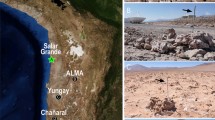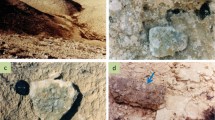Abstract
Understanding how microbial communities adapt to environmental stresses is critical for interpreting ecological patterns and microbial diversity. In the case of the Gobi Desert, little is known on the environmental factors that explain hypolithic colonization under quartz stones. By analyzing nine hypolithic communities across an arid gradient and the effects of the season of the year in the Hexi Corridor of this desert, we found a significant decrease in hypolithic colonization rates (from 47.24 to 15.73%) with the increasing drought gradient and found two distinct communities in Hot and Cold samples, which survived or proliferated after a hot or a cold period. While Cold communities showed a greater species diversity and a predominance of Cyanobacteria, Hot communities showed a predominance of members of the Proteobacteria and the Firmicutes. In comparison, Cold communities also possessed stronger functions in the photosynthesis and carbon metabolism. Based on the findings of this study, we proposed that the hypolithic communities of the Hexi Corridor of the Gobi Desert might follow a seasonal developmental cycle in which temperature play an important role. Thus after a critical thermal threshold is crossed, heterotrophic microorganisms predominate in the hot period, while Cyanobacteria predominate in the cold period.






Similar content being viewed by others
Data Availability
The DNA sequences have been deposited in the NCBI (https://www.ncbi.nlm.nih.gov/) Sequence Read Archive (SRA) database under the BioProject ID PRJNA763772.
Code Availability
All codes for analysis can be obtained by contacting the corresponding author.
References
Sternberg T, Rueff H, Middleton N (2015) Contraction of the Gobi Desert, 2000–2012. Remote Sens 7(2):1346–1358
Viles HA (2005) Microclimate and weathering in the central Namib Desert. Namibia Geomorphol 67(1–2):189–209
Liu JL, Li FR, Liu CA, Liu QJ (2012) Influences of shrub vegetation on distribution and diversity of a ground beetle community in a Gobi desert ecosystem. Biodivers Conserv 21(10):2601–2619
Friedmann EI, Galun M (1974) Desert algae, lichens and fungi. In: Brown Jr. GW, editor. Desert biology: special topics on the physical and biological aspects of arid regions. 2. New York: Academic Press. p. 165–212
Golubic S, Friedmann EI, Schneider J (1981) The lithobiontic ecological niche, with special reference to microorganisms. J Sediment Petrol 51(2):475–478
Pointing SB (2016) Hypolithic communities. In: Weber B, Büdel B, Belnap J, editors. Biological soil crusts: An organizing principle in drylands. Switzerland: Springer, Cham. p. 199–213.
Pointing SB, Belnap J (2012) Microbial colonization and controls in dryland systems. Nat Rev Microbiol 10(8):551–562
Chan Y, Van Nostrand JD, Zhou JZ, Pointing SB, Farrell RL (2013) Functional ecology of an Antarctic Dry Valley. Proc Natl Acad Sci USA 110(22):8990–8995
Wei STS, Fernandez-Martinez MA, Chan YK, Van Nostrand JD, de los Rios-Murillo A, Chiu JMY, et al. (2015) Diverse metabolic and stress-tolerance pathways in chasmoendolithic and soil communities of Miers Valley, McMurdo Dry Valleys, Antarctica. Polar Biol 38(4):433–43
Sciuto K, Moro I (2015) Cyanobacteria: the bright and dark sides of a charming group. Biodivers Conserv 24(4):711–738
Cowan DA, Sohm JA, Makhalanyane TP, Capone DG, Green TGA, Cary SC et al (2011) Hypolithic communities: important nitrogen sources in Antarctic desert soils. Environ Microbiol Rep 3(5):581–586
Valverde A, Makhalanyane TP, Seely M, Cowan DA (2015) Cyanobacteria drive community composition and functionality in rock–soil interface communities. Mol Ecol 24(4):812–821
Lebre PH, Bottos E, Makhalanyane TP, Hogg I, Cowan DA (2021) Islands in the sand: are all hypolithic microbial communities the same? FEMS Microbiol Ecol 97(1):fiaa216
Pointing SB, Warren-Rhodes KA, Lacap DC, Rhodes KL, Mckay CP (2007) Hypolithic community shifts occur as a result of liquid water availability along environmental gradients in China’s hot and cold hyperarid deserts. Environ Microbiol 9(2):414–424
Stomeo F, Valverde A, Pointing SB, McKay CP, Warren-Rhodes KA, Tuffin MI et al (2013) Hypolithic and soil microbial community assembly along an aridity gradient in the Namib Desert. Extremophiles 17(2):329–337
Warren-Rhodes KA, Rhodes KL, Pointing SB, Ewing SA, Lacap DC, Gómez-Silva B et al (2006) Hypolithic cyanobacteria, dry limit of photosynthesis, and microbial ecology in the hyperarid Atacama Desert. Microb Ecol 52(3):389–398
Warren-Rhodes KA, Rhodes KL, Boyle LN, Pointing SB, Chen Y, Liu SJ et al (2007) Cyanobacterial ecology across environmental gradients and spatial scales in China’s hot and cold deserts. FEMS Microbiol Ecol 61(3):470–482
Caruso T, Chan Y, Lacap DC, Lau MCY, McKay CP, Pointing SB (2011) Stochastic and deterministic processes interact in the assembly of desert microbial communities on a global scale. ISME J 5(9):1406–1413
Azúa-Bustos A, González-Silva C, Mancilla RA, Salas L, Gómez-Silva B, McKay CP et al (2011) Hypolithic cyanobacteria supported mainly by fog in the coastal range of the Atacama desert. Microb Ecol 61(3):568–581
Warren-Rhodes KA, McKay CP, Boyle LN, Wing MR, Kiekebusch EM, Cowan DA et al (2013) Physical ecology of hypolithic communities in the central Namib Desert: the role of fog, rain, rock habitat, and light. J Geophys Res-Biogeo 118(4):1451–1460
Berner T, Evenari M (1978) The influence of temperature and light penetration on the abundance of the hypolithic algae in the Negev desert of Israel. Oecologia 33(2):255–260
Cockell CS, Stokes MD (2004) Ecology: widespread colonization by polar hypoliths. Nature 431(7007):414
Cockell CS, Stokes MD (2006) Hypolithic colonization of opaque rocks in the Arctic and Antarctic Polar Desert. Arct Antarct Alp Res 38(3):335–342
Wong FKY, Lacap DC, Lau MCY, Aitchison JC, Cowan DA, Pointing SB (2010) Hypolithic microbial community of quartz pavement in the high-altitude tundra of central Tibet. Microb Ecol 60(4):730–739
Cowan DA, Khan N, Pointing SB, Cary SC (2010) Diverse hypolithic refuge communities in the McMurdo Dry Valleys. Antarct Sci 22(6):714–720
Wood SA, Rueckert A, Cowan DA, Cary SC (2008) Sources of edaphic cyanobacterial diversity in the Dry Valleys of Eastern Antarctica. ISME J 2(3):308–320
Scola V, Ramond J-B, Frossard A, Zablocki O, Adriaenssens EM, Johnson RM et al (2018) Namib Desert soil microbial community diversity, assembly, and function along a natural xeric gradient. Microb Ecol 75(1):193–203
Cowan DA, Hopkins DW, Jones BE, Maggs-Kölling G, Majewska R, Ramond J-B (2020) Microbiomics of Namib desert habitats. Extremophiles 24(1):17–29
Bao C, Fang CL (2007) Water resources constraint force on urbanization in water deficient regions: a case study of the Hexi Corridor, arid area of NW China. Ecol Econ 62(3–4):508–517
Zhang ZC, Dong ZB (2015) Grain size characteristics in the Hexi Corridor Desert. Aeol Res 18:55–67
Gao LM, Zhang YN (2016) Spatio-temporal variation of hydrological drought under climate change during the period 1960–2013 in the Hexi Corridor, China. J Arid Land 8(2):157–171
Waite S (2000) Statistical ecology in practice: a guide to analysing environmental and ecological field data. Addison-Wesley Longman Ltd, New York
Caporaso JG, Kuczynski J, Stombaugh J, Bittinger K, Bushman FD, Costello EK et al (2010) QIIME allows analysis of high-throughput community sequencing data. Nat Methods 7(5):335–336
Nylen TH, Fountain AG, Doran PT (2004) Climatology of katabatic winds in the McMurdo dry valleys, southern Victoria Land. Antarct J Geophys Res Atmos 109:D03114
Weber B, Wessels DC, Deutschewitz K, Dojani S, Reichenberger H, Büdel B (2013) Ecological characterization of soil-inhabiting and hypolithic soil crusts within the Knersvlakte. S Afr Ecol Process 2(1):1–13
Makhalanyane TP, Valverde A, Birkeland N-K, Cary SC, Tuffin IM, Cowan DA (2013) Evidence for successional development in Antarctic hypolithic bacterial communities. ISME J 7(11):2080–2090
Lacap-Bugler DC, Lee KK, Archer S, Gillman LN, Lau MCY, Leuzinger S et al (2017) Global diversity of desert hypolithic cyanobacteria. Front Microbiol 8:867
Fernandes TA, Iyer V, Apte SK (1993) Differential responses of nitrogen-fixing cyanobacteria to salinity and osmotic stresses. Appl Environ Microbiol 59(3):899–904
Moisander PH, McClinton E 3rd, Paerl HW (2002) Salinity effects on growth, photosynthetic parameters, and nitrogenase activity in estuarine planktonic cyanobacteria. Microb Ecol 43(4):432–442
Apte SK, Thomas J (1997) Possible amelioration of coastal soil salinity using halotolerant nitrogen-fixing cyanobacteria. Plant Soil 189(2):205–211
Chan YK, Lacap DC, Lau MCY, Ha KY, Warren-Rhodes KA, Cockell CS et al (2012) Hypolithic microbial communities: between a rock and a hard place. Environ Microbiol 14(9):2272–2282
Delgado-Baquerizo M, Oliverio AM, Brewer TE, Benavent-González A, Eldridge DJ, Bardgett RD et al (2018) A global atlas of the dominant bacteria found in soil. Science 359(6373):320–325
Lauber CL, Hamady M, Knight R, Fierer N (2009) Pyrosequencing-based assessment of soil pH as a predictor of soil bacterial community structure at the continental scale. Appl Environ Microbiol 75(15):5111–5120
Sun HJ, Friedmann EI (1999) Growth on geological time scales in the Antarctic cryptoendolithic microbial community. Geomicrobiol J 16(2):193–202
Le PT, Makhalanyane TP, Guerrero LD, Vikram S, Van de Peer Y, Cowan DA (2016) Comparative metagenomic analysis reveals mechanisms for stress response in hypoliths from extreme hyperarid deserts. Genome Biol Evol 8(9):2737–2747
Ozyigit II, Filiz E, Vatansever R, Kurtoglu KY, Koc I, Öztürk MX et al (2016) Identification and comparative analysis of H2O2-scavenging enzymes (ascorbate peroxidase and glutathione peroxidase) in selected plants employing bioinformatics approaches. Front Plant Sci 7:301
Fallon RD, Brock TD (1979) Decomposition of blue–green algal (cyanobacterial) blooms in lake Mendota, wisconsin. Appl Environ Microbiol 37(5):820–830
Nedzarek A, Rakusa-Suszczewski S (2004) Decomposition of macroalgae and the release of nutrient Admiralty Bay, King George, Antarctica. Polar Biosci 17:26–35
Liu JJ, Sui YY, Yu ZH, Shi Y, Chu HY, Jin J et al (2014) High throughput sequencing analysis of biogeographical distribution of bacterial communities in the black soils of northeast China. Soil Biol Biochem 70:113–122
Zhang KP, Delgado-Baquerizo M, Zhu YG, Chu HY (2020) Space is more important than season when shaping soil microbial communities at a large spatial scale. mSystems 5(3):e00783–19
Dini-Andreote F, de Cassia Pereira e Silva M, Triado-Margarit X, Casamayor EO, van Elsas JD, Salles JF (2014) Dynamics of bacterial community succession in a salt marsh chronosequence: evidence for temporal niche partitioning. ISME J 8(10):1989–2001
Faust K, Lahti L, Gonze D, de Vos WM, Raes J (2015) Metagenomics meets time series analysis: unravelling microbial community dynamics. Curr Opin Microbiol 25:56–66
Cermeño P, Falkowski PG (2009) Controls on diatom biogeography in the ocean. Science 325(5947):1539–1541
Chu HY, Fierer N, Lauber CL, Caporaso JG, Knight R, Grogan PJEm (2010) Soil bacterial diversity in the Arctic is not fundamentally different from that found in other biomes. Environ Microbiol 12(11):2998–3006
Funding
The work was supported by the National Natural Science Foundation of China (31870479); the National Key R&D Program of China (2019YFE0121100); the Scientific Project of Gansu Province, China (20YF3WA007, 20JR5RA548); and the CAS “Light of West China” Program.
Author information
Authors and Affiliations
Contributions
Ming-Hui Wu: methodology, investigation, data curation, writing—original draft. Ting Li: methodology, writing—review and editing. Gao-Sen Zhang: conceptualization; investigation; writing, review and editing; funding acquisition. Fa-Si Wu: investigation. Tuo Chen: supervision, funding acquisition. Bing-Lin Zhang: investigation, methodology, funding acquisition. Xiu-Kun Wu: investigation, methodology. Guang-Xiu Liu: supervision, funding acquisition. Ke-Cun Zhang: methodology. Zhang Wei: supervision, funding acquisition.
Corresponding author
Ethics declarations
Conflict of Interest
The authors declare no competing interests.
Supplementary Information
Below is the link to the electronic supplementary material.
Rights and permissions
About this article
Cite this article
Wu, MH., Li, T., Zhang, GS. et al. Seasonal Variation of Hypolithic Microbiomes in the Gobi Desert. Microb Ecol 85, 1382–1395 (2023). https://doi.org/10.1007/s00248-022-02043-3
Received:
Accepted:
Published:
Issue Date:
DOI: https://doi.org/10.1007/s00248-022-02043-3




